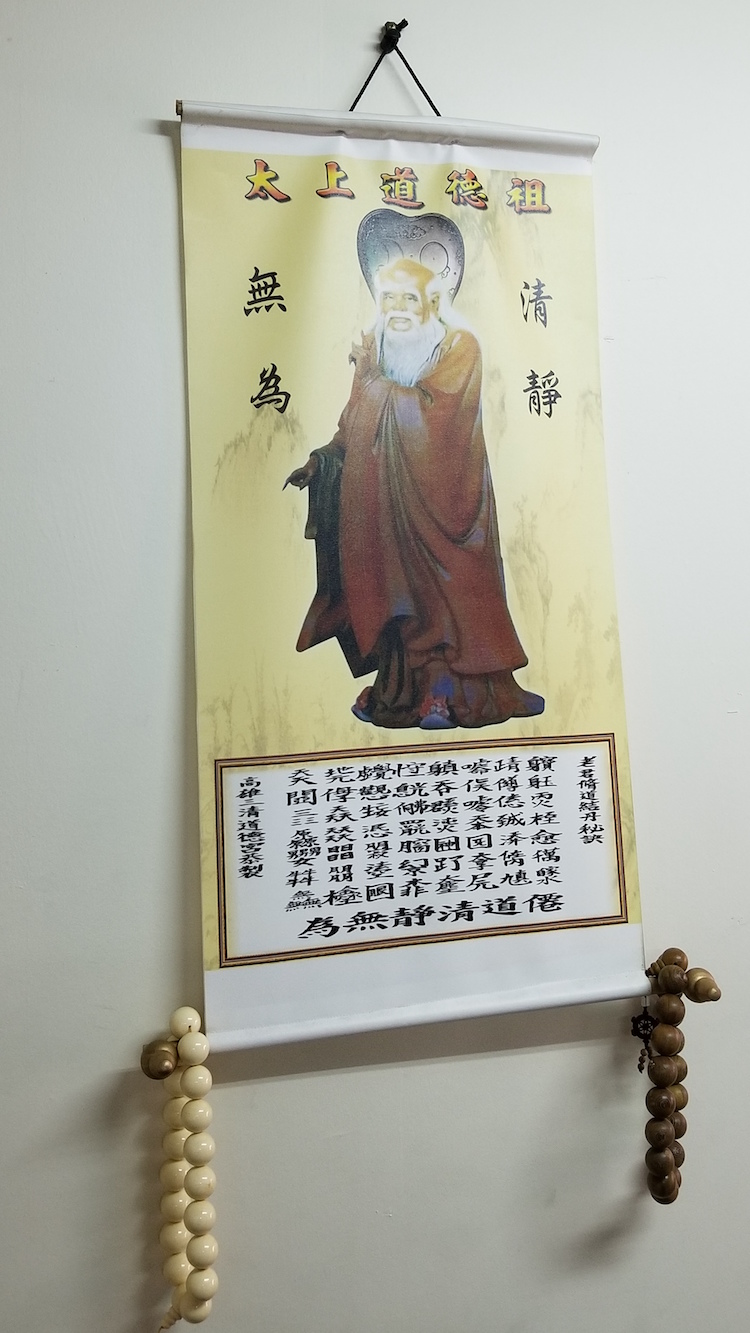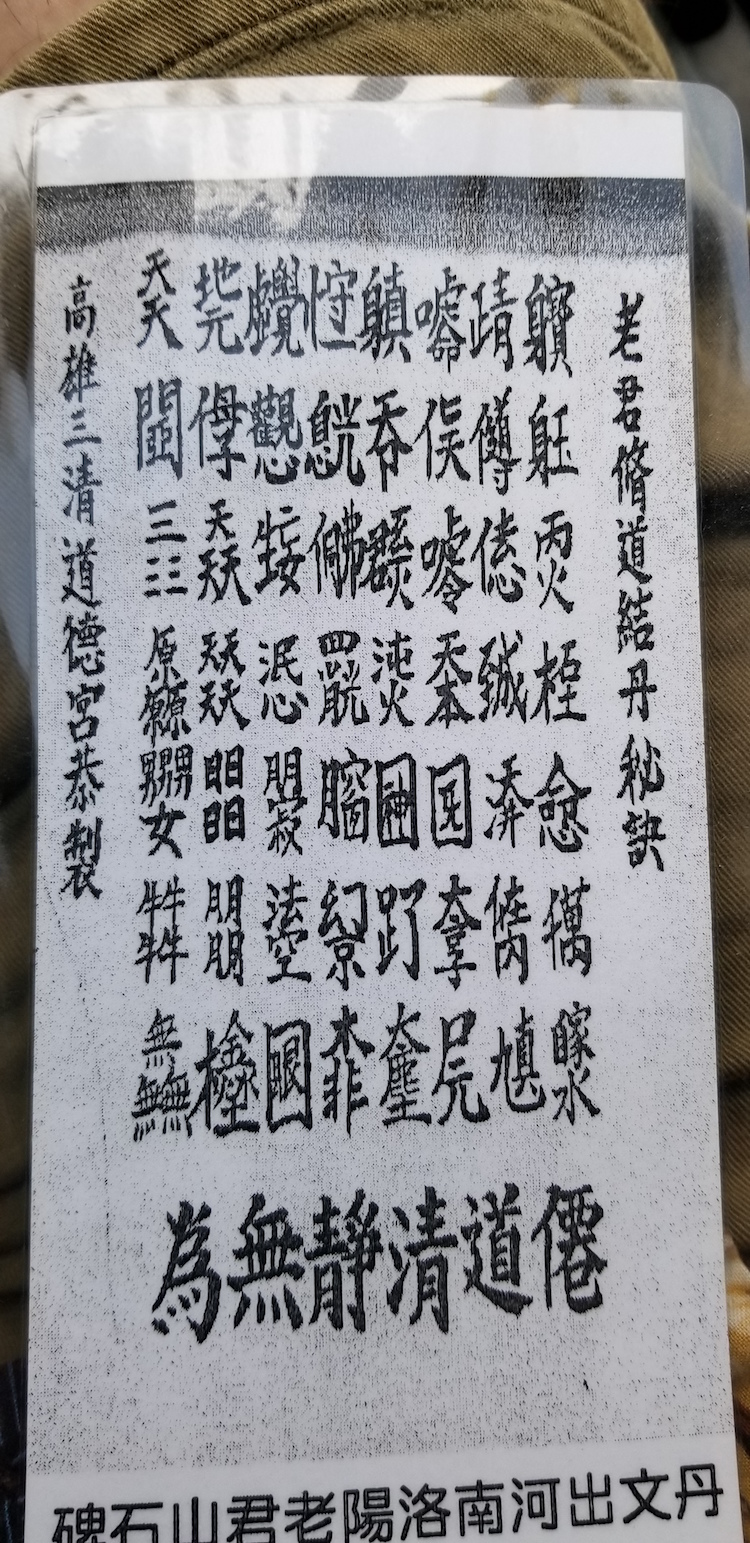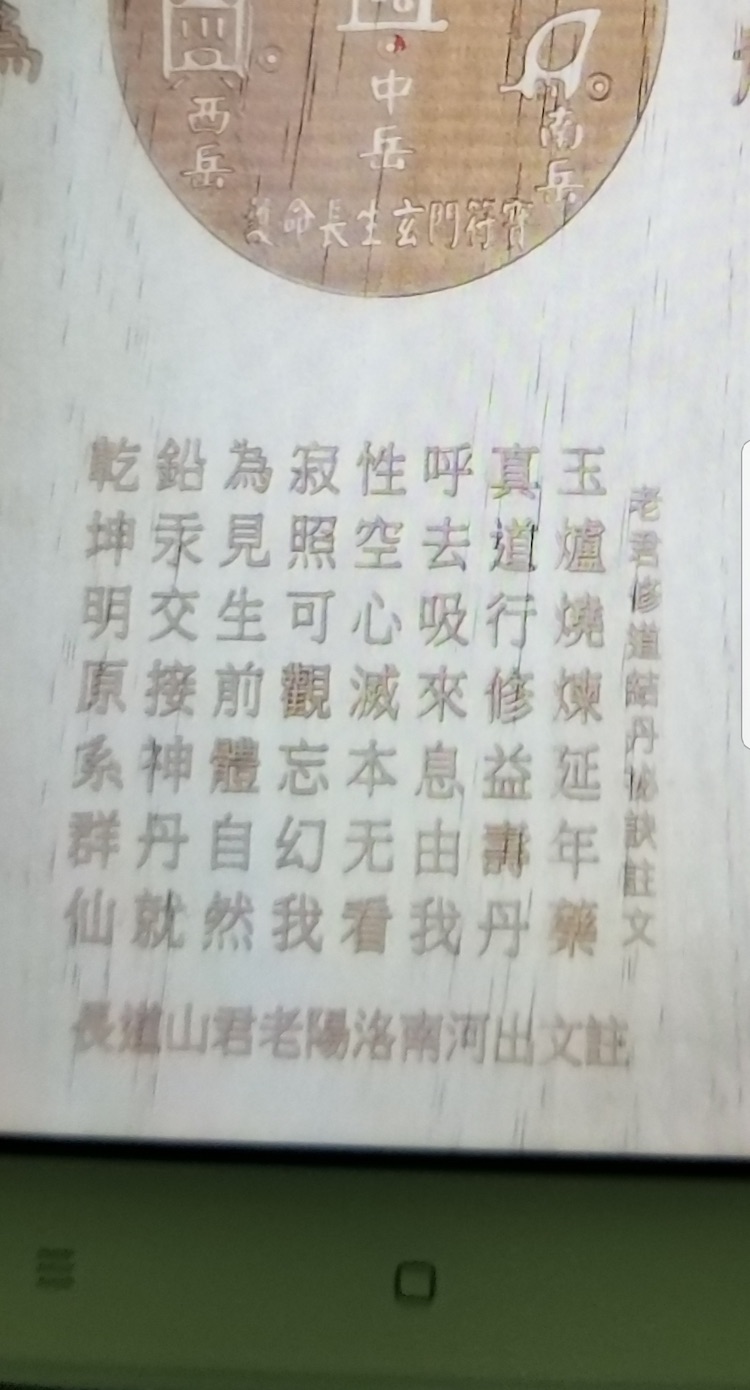Mystical Taoist Sinographs
« previous post | next post »
Jason Cox, who sent the following photograph to me, says that his "uncle-in-law has this all over the place":
Here's a closeup of a different exemplar (woven into a textile) of the bottom part:
A few of the characters written here may actually be "real" in the sense that they may have occurred one or more times before in history and are among the over 100,000 Sinographs that have been gathered together in the biggest dictionaries and data bases. But most of them have been made up by the author(s) of this text, though not entirely whimsically as with Xu Bing's "A Book from the Sky":
"The unpredictability of Chinese character formation and pronunciation" (2/6/12)
Rather, the characters in this dānwén 丹文 ("cinnabar writing") largely consist of components (mostly themselves characters) that individually and collectively make a sort of sense. Thus tiān 天 ("heaven" over běn 本 ("root") might mean something like "root of heaven" and shēn 身 ("body") next to zhēn 真 ("true") might mean something like "true body". Some of these made-up characters are quite cryptic, such as three men over one woman or the character for "eye" or "spirit" inside of an enclosure.
Jason's uncle-in-law is a Taoist and he says that he can "read" this text. Here's the "annotation" (zhùwén 註文) by means of which the text can be read as Literary Sinitic / Classical Chinese:
And here's a link to the audio.



Andreas Johansson said,
May 2, 2018 @ 1:16 am
Victor Mair wrote:
Some of these made-up characters are quite cryptic, such as three men over one woman
Reminds me of the (well-known?) story that the Chinese characters for "argument" and "gossip" consists of that for "woman" repeated twice and trice respectively. Based on similar prejudice, I guess the character you mention should mean either "rivalry" or "promiscuity".
The Suffocated said,
May 2, 2018 @ 1:22 am
The first figure has eight columns/sentences, each containing eight characters. The second figure also has eight columns, but each column has only seven characters. How are they related to each other?
martin schwartz said,
May 2, 2018 @ 1:25 am
As a boy ca. 1953 I had a book on coin collecting, withinteresting international coins. Most memorable were a coin from the Celebes
(interesting script), a table of conversion from Islamic to Western years,
and, best of all, a black-and-white photo of a large Chinese "alchemical coin", which I assume was Daoist. It had no hole, and featured the big head of a robed bearded
bald sage, with odd characters. It intrigued me; pity I somehow no longer have the book.Has anyone seen the like?
Martin Schwartz
Michael Watts said,
May 2, 2018 @ 1:35 am
奻 is in Unihan, but it doesn't have an entry in the ABC dictionary or CC-CEDICT at all.
姦 (simplified form 奸) is a word in current use, but means (in the single context where I encountered it) "rape". Dictionary entries all seem to agree that it is restricted to sexual meanings; the xiandai hanyu guifan cidian defines it as 男女间发生不正当的或不合法的性行为, "improper or illegal sexual behavior happening between a male and a female".
As far as modern Chinese goes, there is no single character for "woman" (or if there is, it is not commonly used); 女 is an adjective.
Michael Watts said,
May 2, 2018 @ 1:39 am
The Suffocated, the first figure has 8 columns containing 7 characters each, the second figure has 8 columns consisting of 7 characters each, and they are related to each other in that the characters are all identical.
The last row (of each) contains only 6 characters, not 8 characters as you assert; it is different from the prior 7 rows.
Andreas Johansson said,
May 2, 2018 @ 1:58 am
@Michael Watts:
Thanks for the additional background. I did google to see if there was any truth to the story, and took the "rape" reading as confirmation there isn't. Maybe I should have mentioned it.
Is it known, BTW, how that character ended up with that meaning?
The Suffocated said,
May 2, 2018 @ 2:22 am
@Michael Watts
You are right. I stand corrected, but I still don't believe that the two figures point to the same thing. Note that in the second figure, the character 我 appears twice in the bottom row, but in the first figure, the two Taoist characters are different.
The correspondences between the two character arrays at other positions also do not seem right. E.g. the first two chinese characters on the last/leftmost column of the second figure are 乾 and 坤, which mean 天 (heaven) and 地 (earth) in trigrams. However, in the Taoist array, it is 鉛 (lead, the first character to the right of 乾) whose Taoist character has a 地 component, and 鉛 belongs to the "metal" (金) category rather than "earth" in the Five Elements.
I think there are multiple such Taoist scripts and the second figure is possibly the annotation for another script.
Anthony said,
May 2, 2018 @ 2:32 am
The third graph in the leftmost row of the danwen show the trigrams Qian and Kun. The words for Qian and Kun do occur in the annotation, but in a different position. Perhaps there is a possibility that the graphs of the danwen "encode" multiple hanzi?
Incidentally, if the two trigrams are taken together in the order shown, the resulting hexagram is Pi, the twelth hexagram of the Yi Jing. One wonders if the symbolism of the hexagram would provide an extra layer of meaning to the text to adepts.
Michael Watts said,
May 2, 2018 @ 2:47 am
Ah, I was talking about the first and second images, without considering the third.
I don't see any particular reason why two nonexistent characters in a mystical text shouldn't "translate" to the same word in the legible text of the same, though.
jdmartinsen said,
May 2, 2018 @ 2:58 am
There's blog post here that offers a fairly detailed explanation of the construction of the first two lines. (A rendering there suggests that the first 我 in the above image may actually be 吾, a different personal pronoun that doesn't affect the meaning.)
There's also a book, 老君碑留古字解玉皇心印妙经直解 by 王燕喜 and 董沛文, that explicates this and other similar texts.
Anthony said,
May 2, 2018 @ 4:17 am
Update: There also appeas to be an alternate version of the danwen. it is shown in the article below. This article also provides a fairly comprehensive account of the danwen's decipherment ( in Chinese)
http://qhwh.qxzc.net/qhwhyj3/html/2008/7/155.htm
John Rohsenow said,
May 2, 2018 @ 7:26 am
"…the xiandai hanyu guifan cidian defines it as 男女间发生不正当的或不合法的性行为, "improper or illegal sexual behavior happening between a male and a female".
As I recall, during the Cultural Revolution and shortly thereafter, this definition was used to prosecute people of "rape". This dictionary
definition may reflect that strict reading. Not sure if it is still in force now,
but somehow I doubt it.
John Rohsenow said,
May 2, 2018 @ 7:31 am
Also, someone mentioned the other day (was it on PBS?) that Buddhism is very much a religion of written texts. Can we see these Daoist mystical characters as a deliberate contrast to Buddhist practices?
Andrew said,
May 2, 2018 @ 8:51 am
What is an "uncle-in-law"? Your aunt's husband (which I would "my uncle") or your wife's uncle ("my wife's uncle")?
And now the word "uncle" looks really weird to me – what is the name of this phenomenon?
Victor Mair said,
May 2, 2018 @ 9:08 am
@Andrew
I wondered about that myself, but I think he means his wife's uncle.
Victor Mair said,
May 2, 2018 @ 9:08 am
From John Lagerwey:
Very interesting, Victor, but most of the commentators are ill-informed. There are zillions of “mystical Taoist sinographs” used in ritual, in the formation of talismans, and conglomerating characters to make illegible but highly meaningful, esoteric characters is quite common. These are things I know but have not studied, and to study them thoroughly would take a lot of time and a great deal of interest. Having neither, I’ll not do it, but one of the bloggers ought to, rather than saying n’importe quoi.
Victor Mair said,
May 2, 2018 @ 6:49 pm
For those who are not familiar with Chinese character composition, the elements / components of characters, if they are themselves characters, should not be thought of as Mandarin words, which are on average two syllables in length, but as Literary Sinitic monosyllables.
Spor said,
May 3, 2018 @ 4:24 am
@The Suffocated
The "translation" is the same as the original. 铅 in the context of alchemy, 真铅, is in the trigrams correlated to the middle yang line of of the kan water trigram, while 真汞 refers to the middle yin line of the li fire trigram. 铅 is thus rendered here as 地元, earth essense, because it differs from the fully yin kun earth trigram for its central yang. It's not correlating it to the five phase earth, but the trigram water, which is a "son" of the earth trigram. Its rather convoluted, but the translation matches.
Victor Mair said,
May 3, 2018 @ 12:16 pm
From Patrice Fava:
C'est un texte neidan bien connu des daoshi qui a été gravé sur une stèle (mais je ne sais plus à quelle époque). Il a été, entre autres, commenté par Ren Farong. Je te donnerai toutes les références très prochainement, car je ne suis pas souvent à la maison en ce moment.
Victor Mair said,
May 3, 2018 @ 11:57 pm
From Patrice Fava:
I am glad to be able to provide some information about the “Mystical Taoist Sinographs”. The beginning of the text (the first 14 sinographs) is a duilian 对联 and comes from a stele untitled老子十四字养生诀. Here I copy a calligraphy and give you some explanations of the first sinographs, sometimes considered as tianshu 天书 !
太上老君十四字养生箴言
The first character “身”+“寶”means 以身为寶。
The second character “身”+“丹”means body has to be refined (煉丹) and refers to 精、气、神 :
The third character 丙+火 has to be read as 一、内、火 . It represents the trigram kan 坎 :
The fourth character combines 木石土 and refers to the 阴阳五行.
The fifth character “心”+“命”refers to 性命雙修。
The sixth character 千+萬 is for longevity 千萬年。
etc.
These fourteen characters have been explained in a book written by 任法融 and published by天台县紫阳宫. I just order the book and will receive it in few days, but apparently the text is also on the website
http://www.360doc.com/content/16/0222/19/99504_536497720.shtml
Right now, I am unable to download it, I need a special account and a password. I will get them this evening and will be able to forward it to you.
By the way, let me also mention that, some years ago, Li Chongming 李崇明, a former Gaogong of Baiyunguan in Beijing, made a one hour lecture about this text, and I made a video. If it could be of some interest for you, I could eventually edit it. I don’t know if the conference was inspired by the comments of Ren Farong, or if the book published under his name was made by someone else. I could check it later.
Jerry Packard said,
May 4, 2018 @ 5:07 pm
Wonderful discussion.
tangent said,
May 4, 2018 @ 8:17 pm
@Andrew "And now the word "uncle" looks really weird to me – what is the name of this phenomenon?"
"Semantic satiation".
(I've always wished to try this under fMRI — anyone seen that done?)